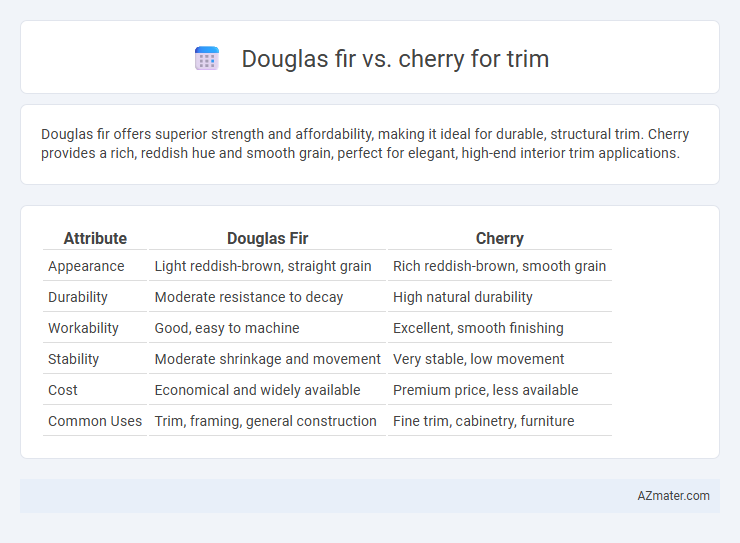Douglas fir offers superior strength and affordability, making it ideal for durable, structural trim. Cherry provides a rich, reddish hue and smooth grain, perfect for elegant, high-end interior trim applications.
Table of Comparison
| Attribute | Douglas Fir | Cherry |
|---|---|---|
| Appearance | Light reddish-brown, straight grain | Rich reddish-brown, smooth grain |
| Durability | Moderate resistance to decay | High natural durability |
| Workability | Good, easy to machine | Excellent, smooth finishing |
| Stability | Moderate shrinkage and movement | Very stable, low movement |
| Cost | Economical and widely available | Premium price, less available |
| Common Uses | Trim, framing, general construction | Fine trim, cabinetry, furniture |
Introduction to Douglas Fir and Cherry for Trim
Douglas fir offers exceptional strength and stability, making it a popular choice for trim in both residential and commercial projects due to its fine, straight grain and warm reddish-brown hue. Cherry wood, prized for its rich, deep reddish tones and smooth texture, enhances interior trims with a luxurious appearance that ages beautifully over time. Both woods provide durable, aesthetic options for trim, with Douglas fir favored for its structural qualities and cherry valued for its elegant finish.
Key Differences Between Douglas Fir and Cherry
Douglas fir trim is known for its strength, straight grain, and affordability, making it ideal for structural elements and rustic interior designs. Cherry trim offers a rich, warm reddish-brown hue with smooth texture and fine grain, preferred for high-end cabinetry and elegant finishes. Key differences include Douglas fir's durability and cost-effectiveness versus cherry's aesthetic appeal and natural luster, influencing trim choice based on project style and budget.
Appearance and Color Comparison
Douglas fir exhibits a light reddish-brown hue with straight, pronounced grain patterns, offering a warm and rustic appearance ideal for natural or contemporary trim designs. Cherry wood features a rich, reddish-brown color that deepens and darkens over time, with a smooth, fine grain that enhances its elegant and sophisticated look. The choice between Douglas fir and Cherry for trim depends on the desired aesthetic: Douglas fir emphasizes rustic texture and light tones, while Cherry provides a polished surface with a deeper, more luxurious color palette.
Durability and Hardness of Douglas Fir vs Cherry
Douglas fir offers moderate durability and hardness, with a Janka hardness rating around 660, making it suitable for trim in areas with low to moderate wear. Cherry wood, rated at approximately 950 on the Janka scale, provides greater hardness and resistance to dents and scratches, enhancing longevity in high-traffic or impact-prone spaces. Douglas fir's strength and stability make it a durable choice, but cherry's superior hardness and fine grain deliver a more resilient and elegant trim option.
Workability and Ease of Installation
Douglas fir offers excellent workability with its straight grain and moderate hardness, making it easy to cut, shape, and nail during trim installation. Cherry wood, while slightly harder, is also workable but requires sharper tools and more precision to avoid splintering. Both woods provide smooth finishes, but Douglas fir's dimensional stability typically results in easier fitting and alignment during installation.
Cost Considerations: Douglas Fir vs Cherry Trim
Douglas fir trim offers a cost-effective option, typically priced lower than cherry wood due to its abundant availability and faster growth rate. Cherry trim commands a premium price, reflecting its rich color, fine grain, and durability, making it a favored choice for high-end interiors. Budget-conscious projects often opt for Douglas fir to balance aesthetics and affordability without sacrificing quality.
Finishing and Staining Options
Douglas fir offers excellent absorption properties for stains, resulting in a vibrant, rich finish with prominent grain patterns that enhance its natural beauty. Cherry wood provides a smooth, uniform surface that responds well to both oil and lacquer finishes, developing a warm patina over time with rich reddish-brown tones. When choosing between the two, Douglas fir is ideal for achieving a rustic, textured look, while cherry is preferred for a refined, elegant appearance with consistent color depth.
Maintenance and Longevity
Douglas fir trim offers exceptional durability and low maintenance due to its dense grain and natural resistance to decay, making it ideal for high-traffic areas. Cherry wood trim, while prized for its rich color and smooth texture, requires more frequent upkeep, including regular polishing to maintain its luster and prevent surface damage. Over time, Douglas fir outlasts cherry in longevity, especially in environments with fluctuating humidity and temperature.
Best Applications for Each Wood Species
Douglas fir excels in trim applications requiring strength and durability, such as baseboards, door casings, and window frames, due to its dense grain and resistance to wear. Cherry wood is ideal for decorative trim and interior accents, offering a rich, reddish hue and smooth texture that enhances upscale architectural details and fine cabinetry. Use Douglas fir in high-traffic or structural areas, while cherry is preferable for elegant finishes where aesthetics are paramount.
Choosing the Right Wood Trim for Your Project
Douglas fir offers exceptional strength and durability, making it ideal for trim in high-traffic areas or exterior projects due to its resistance to wear and decay. Cherry wood provides a rich, warm tone with a smooth grain, perfect for interior trim where aesthetic appeal and fine finishing are priorities. Selecting between Douglas fir and cherry depends on balancing durability needs with desired visual warmth and grain complexity in your wood trim installation.

Infographic: Douglas fir vs Cherry for Trim
 azmater.com
azmater.com